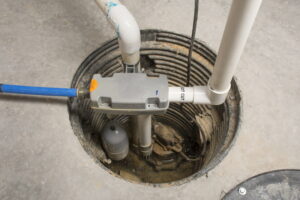For some homes, a fully-operational sump pump is the only way to avoid flooding and all the mess and bother that goes with it. If this description fits your home, you know firsthand how important your sump pump is. You definitely don’t want it to fail during a sudden heavy rainstorm!
But what if you’re not sure that your sump pump is in good condition? Regular maintenance is always a good plan. Your technician can catch any problems early and make sure your pump is ready for the next onslaught of water. If you have specific concerns, you might be wondering whether you need to schedule repair. Here are three big signs that it’s time for a plumber to look at your sump pump.
1: Running—or Not Running—at the Wrong Times
If your home is absolutely dry and you hear your sump pump running, you’re probably wondering what on earth it’s trying to pump out. This can happen when there is a clog, which might be composed of mold or mud. You can check for clogs, try to remove them, or schedule service so a professional can give it a thorough cleaning.
Another possibility when a sump pump tries to run while dry, if it is quite new, is that a problem occurred during installation. In this case, it’s important to get sump pump repair in Duluth, GA so that your new pump doesn’t damage itself by straining the motor unnecessarily.
And what if your basement is flooding, but your sump pump is not running? Chances are, the culprit is the float switch. This is the mechanism that registers the depth of water in your sump pit. When it reaches a certain level, it triggers the pump to come on. If the float switch is stuck or broken, the pump is simply never receiving the signal to turn on.
2: Slow Draining
If the pump is working, but the progress it makes is not sufficient, or it used to pump more water in less time and has been slowing down, there are a couple of possibilities.
First, there may be a partial blockage or clog. Mud, silt, and other particles can settle out of water and gum up the works. Mold can grow and obstruct the flow of water. And outdoor debris like dead leaves can be blown into the drain.
Second, a pump can slow down over time due to problems with the motor. If your pump is old or sees heavy use, this becomes increasingly likely. If you can’t identify and clear out a clog, a qualified plumber can determine whether there’s a sneaky blockage or if the motor is the actual issue.
3: Cracked Sump Pit
The sump pit or basin is the reservoir that contains your sump pump. A small amount of cracking in the concrete of the pit can be easily repaired. It might be hard to spot when cracking happens, because it could be at the bottom of the pit where there’s often a layer of silt. These cracks can allow groundwater to fill the pit, creating a lot more work for your pump, leading to wear and tear and even breakdown. Significant cracking could warrant replacing the basin entirely, which is a bit of an undertaking but would help your sump pump to work less and live longer.
For all your plumbing needs, contact DC Cheek Heating, Cooling & Plumbing today. Fixed, At the Speed of Life!




